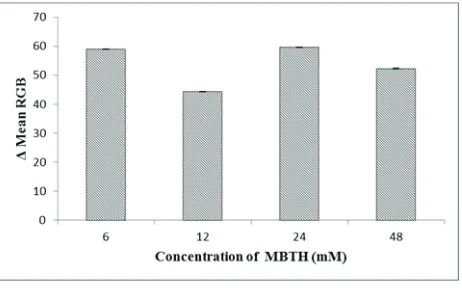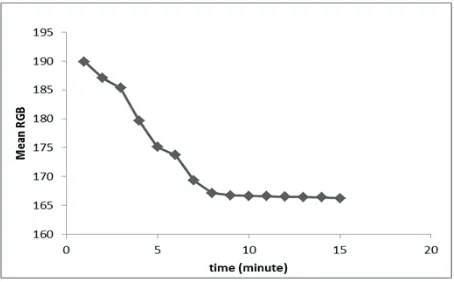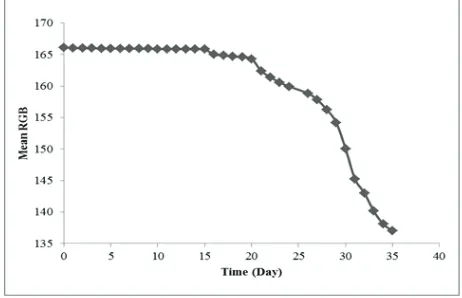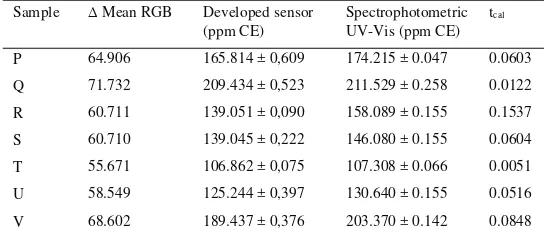Agriculture and Agricultural Science Procedia 9 ( 2016 ) 424 – 430
2210-7843 © 2016 The Authors. Published by Elsevier B.V. This is an open access article under the CC BY-NC-ND license (http://creativecommons.org/licenses/by-nc-nd/4.0/).
Peer-review under responsibility of the organizing committee of IC-FANRes 2015
doi: 10.1016/j.aaspro.2016.02.159
ScienceDirect
ScienceDirect
ScienceDirect
International Conference on Food, Agriculture, and Natural Resources, FANRes2015
Development of Paper Based Sensor for The Determination of Total
Phenolic Content in Green Tea Beverages
Mochammad Amrun Hidayat
a*, Fadilatul Jannah
b, Bambang Kuswandi
ba
Pharmaceutical Biology Department, Faculty of Pharmacy, University of Jember, Kalimantan I/2, Jember 68121, Indonesia
b
Pharmaceutical Chemistry Department, Faculty of Pharmacy, University of Jember, Kalimantan I/2, Jember 68121, Indonesia
Abstract
Tea (Camellia sinensis L.) is one of the most popular beverages around the world. Tea was reported to contain polyphenols, which play a key role in treatment and preventing of many diseases such as cardiovascular and neurodegenerative diseases. Thus, the content of polyphenols could be used as indicator for the quality of tea. Here, the development of low-cost, portable and disposable sensor for determination of green tea quality is described. The sensor was based on immobilization of sodium metaperiodate (NaIO4) in paper as a test strip. NaIO4 was coupled with 3-methyl-2-benzothiazolinone hydrazone (MBTH) as
coloring agent. The polyphenols sensor has response time 9 minutes and a linear range at 25-300 ppm, with a detection limit 10.2 ppm toward catechin. The reproducibility of sensor was 0.628% with life time within 20 days when stored at 4oC. The total polyphenol content in green tea beverages were determined by the sensor, and the results were in agreement with the Folin Ciocalteu assay. The developed sensor can be used as a tool for determination total polyphenol content in tea samples.
© 2016 The Authors. Published by Elsevier B.V.
Peer-review under responsibility of the Scientific committee of FANRes2015
Keywords: sensor, NaIO4, MBTH, polyphenols, green tea;
1.Introduction
Processed tea, which is one of the most popular beverages, is manufactured from the young tender leaves of the plant Camellia sinensis L. (Cabrera et al., 2006). Tea is reported to contain nearly 4000 bioactive compounds of which one third is polyphenols (Tariq et al., 2010). Polyphenols (PPHs) from tea possess much biological activity such as anticancer, antiinflammation, antibacterial, antiobesity, anti HIV, and antidiabetic (Adcocks et al., 2008; Mares et al., 2004; Shimamura et al., 2007; Wu and Yu, 2006; Ogle, 2009; Scalbert et al., 2005). PPHs of green tea
* Corresponding author. Tel.: +6-233-132-4736; fax: +6-233-132-4736.
E-mail address: [email protected]
© 2016 The Authors. Published by Elsevier B.V. This is an open access article under the CC BY-NC-ND license (http://creativecommons.org/licenses/by-nc-nd/4.0/).
also play a key role in treatment and prevent of many diseases such as cardiovascular (Arab et al., 2011) and neurodegenerative diseases (Okello et al., 2010).
The content of PPHs dictate the quality of tea especially catechin which affect to taste, healthy and color of the tea (Anesini et al., 2011). There are different methods to detect the presence of PPHs such as chromatographic, spectrophotometric and electrochemical methods (Xue and Shen, 2002; Photinon et al., 2010). However, they are time consuming, require specific instruments and qualified staff (Gomes and Rebello, 2003). Therefore the development of low-cost, portable and disposable PPHs sensor is needed.
On the other hand, sodium metaperiodate (NaIO4) oxidizes o-diphenol to o-quinones but does not hydroxylate monophenols to o-diphenols (Munoz et al., 2004). In all cases, the resulting quinones may undergo non-enzymatic autopolymerization to produce colored compounds (Oktem et al., 2012). However, quinones also can produce red compounds with 3-methyl-2-benzothiazolinone hydrazone (MBTH). Therefore the development of PPHs sensor with NaIO4 can be done by detection quinones that forming red compounds with MBTH (Hamzah et al., 2011).
Base on the above reaction, here we developed a new optical sensor for simple and rapid detection of PPHs using a strip test. The strip test was fabricated by simply immobilized the reagent on the filter paper by adsorption method. Thus, the color formation is easily detected by naked eye.
2.Materials and Methods
2.1.Materials
NaIO4 was purchased from Merck, MBTH was purchased from Fluka, and catechin hydrate was purchased from Sigma-Aldrich. NaIO4 and MBTH were dissolved and diluted in phosphate buffer while catechin was dissolved in methanol p.a. The solutions were stored at 4oC. Phosphate buffer was used at pH 7.0. The buffer was prepared with 50 ml of 0.2 M KH2PO4 and 29.1 ml of 0.2 N NaOH and added aquadest up to 200 ml. As support material filter paper (CAT No.1095.093) was purchased from Whatman. The paper was cut into 0.5×0.5 cm2.
2.2.Optimization Studies of NaIO4 and MBTH Concentration
Sensors were prepared by mixing NaIO4 and MBTH solutions (1.5:1 (v/v)) and immobilized into papers. The loaded papers were air dried for 30 minutes. To specify the optimum NaIO4 and MBTH concentration for sensors fabrication several studies were performed. NaIO4 stock solutions were prepared by dissolving 53.5 mg of NaIO4 in phosphate buffer (pH 7.0) and diluted into 1, 2, 4, 6, 8 and 10 mM with phosphate buffer (pH 7.0). During NaIO4 optimization studies the MBTH concentration was kept constant at 24 mM in the mixture of NaIO4-MBTH. For the optimization studies of MBTH solution was diluted to final concentration of 6, 12, 24 and 48 mM in phosphate buffer (pH 7.0). The NaIO4 concentration was kept constant at 8 mM.
2.3.Measurement Procedures
3.Results and Discussion
3.1.Fabrication of Sensor
The fabrication of sensors in the form of test strip was performed by absorption of the mixture of NaIO4 and MBTH solutions onto paper. 10 µl of the mixture solution was loaded onto the paper. After loading, the test strips were dried for 30 minutes, and then the sensor was ready to be used.
3.2.Determination of Optimum NaIO4 and MBTH Concentration
The color change of the sensors was red color when tested with catechin standard (150 ppm). The optimum concentration of the mixture of NaIO4 and MBTH were 8 mM and 24 mM respectively (Fig. 1 and Fig. 2), as the highest color intensity change was obtained. The changes in mean RGB color units were found to be most consistent with increasing catechin concentration, thus the mean RGB values were used as measurements (Fig. 3).
Figure 1. The effect of NaIO4 concentration on sensor response. All of the experiments were carried out in triplicate.
Figure 3. Sensor response over 32-512 µM catechin. All of the experiments were carried out in triplicate.
3.3.Characteristic of Polyphenols Sensor
The response time of sensor was observed to be at 9 minutes as after this, it gave stable response of (Fig. 4). Therefore, this response times was used for further experiments. The sensor has a linear response range within catechin in the range of 25-300 ppm (Fig. 5). Sensitivity of sensors is described as the slope of linear curve is calculated to be 0.1566 Δmean RGB/ppm catechin equivalent (CE). The detection limit of the sensor is 10.199 ppm CE while the quantitation limit of the sensor is 33.997 ppm CE.
In order to demonstrate the selectivity of the sensor, a study on the effect of potential interferences in the detection of polyphenols was carried out. The results show that ascorbic acid does not interference in the determination of polyphenols until 1000 ppm of ascorbic acid (1:100 v/v) and it’s confirmed with the value of %interference less than 5% (Harmita, 2004) which exactly 2.01%.
Reproducibility of the sensor using six replicates (n=6) show good result. The RSD for reproducibility of the sensor was calculated to be 0.628%. Small RSD values calculated that less than 2% (Harmita, 2004) for this method indicate a good precision of the developed method.
Accuracy of the sensor was observed by standard addition method. The % recovery values for the accuracy of the sensor on the determination of polyphenols are carried out. The mean of percentage recovery (%) was calculated to be 96.784%, it comply with % recovery values for unit concentration of 100 ppm (90-107%) (Huber, 2007). Therefore this method indicated a good accuracy.
Figure 5. The calibration plot for detection of polyphenols using the developed sensor.
3.4.Stability of Sensor
Stability of reagents used is important in the sensor development. For the stability studies, the sensors were stored in the chiller condition (4°C) and room temperature (25°C). Figure 6 and Figure 7 showed the stability of the sensor versus time. It can be seen from both figures that sensor more stable if it was stored at chiller condition rather than in room temperature. The sensor was stable up to 20 days and afterward, slowly decreased. Theoretically, stability of MBTH decreased with increasing temperature because MBTH is non-stable in room temperature (Yu, 1996). Therefore, the sensor has life time within 20 days when it was stored in chiller condition.
Figure 6. The stability of the developed sensor in chiller condition (4o
Figure 7. The stability of the developed sensor in room temperature at 25o
C.
3.5.Application on Real Sample Analysis
The developed sensor was applied for the detection of polyphenols in beverage green tea products. Green tea beverages (from a local supermarket) were assayed in order to demonstrate the practical used of the sensor. The contents of polyphenols in the samples were calculated using the calibration curve and are listed in Table 1.
The results based on the proposed method were compared with the results assayed using the spectrophotometric UV-Vis (determination total phenolic content using Folin-Ciocalteu method). The results showed that the proposed method were in good agreement with those by the spectrophotometric UV-Vis method, since the calculated t (tcal) were less than table t (ttab) with ttab of 2.145 (df=14 and α=0.05). This is indicating that it is feasible to apply the developed sensor for the determination of polyphenols in real beverage samples.
Table 1. Determination of polyphenols in green tea samples by the developed sensor and UV-Vis Spectrophotometric method. Sample Δ Mean RGB Developed sensor
(ppm CE)
Spectrophotometric UV-Vis (ppm CE)
tcal
P 64.906 165.814 ± 0,609 174.215 ± 0.047 0.0603 Q 71.732 209.434 ± 0,523 211.529 ± 0.258 0.0122 R 60.711 139.051 ± 0,090 158.089 ± 0.155 0.1537 S 60.710 139.045 ± 0,222 146.080 ± 0.155 0.0604 T 55.671 106.862 ± 0,075 107.308 ± 0.066 0.0051 U 58.549 125.244 ± 0,397 130.640 ± 0.155 0.0516 V 68.602 189.437 ± 0,376 203.370 ± 0.142 0.0848
4.Conclusion
Acknowledgements
Thanks to Chemo & Biosensors Group, Faculty of Pharmacy, University of Jember, for supporting this work.
References
Adcocks, C., Collin, P,J., Buttle, D., 2002. Catechins from Green Tea (Camellia sinensis) Inhibit Bovine and Human Cartilage Proteoglycan and Type II Collagen Degradation In Vitro. J. Am. Coll. Nutr. 22(2), 341-346.
Anesini, C.E., Ferraro, G., Filip, R., 2008. Total Polyphenol Content and Antioxidant Capacity of Commercially Available Tea (Camellia sinensis) in Argentina. J. Agric. Food Chem. 56, 9225–9229.
Arab, H., Maroofian, A., Golestani, S., Shafaee, H., Sohrabi, K., Forouzanfar, 2011. A. Review of the Therapeutic Effects of Camellia sinensis (Green Tea) on Oral and Periodontal Health. J. Med. Plant. Res. 5(23), 5465-5469.
Cabrera, C., Artacho, R., Giménez, R. 2006. Beneficial Effects of Green Tea-a Review. J. Am. Coll. Nutr. 25(2), 79–99. Gomes, S. A. S. S., Rebello, M. J. F., 2003. A New Laccase Biosensor for Polyphenol Determination. Sensors. 3: 166-175.
Hamzah, H.H., Yusof, N.A., Salleh, A.B., Bakar, F.A., 2011. An Optical Test Strip for the Detection of Benzoic Acid in Food. Sensors. 11, 7302-7313.
Harmita, 2004. Petunjuk Pelaksanaan Validasi Metode and Cara Perhitungannya. Majalah Ilmu Kefarmasian, I (3), 117-135. Huber, L. 2007. Validation and Qualification in Analytical Laboratories, Second Edition. Informa Health Care, New York.
Mares, M. V. R., Chandra, S., Mejia, E. G., 2004. In vitro Chemopreventive Activity of Camellia sinensis, Ilex paraguariensis and Ardisia compressa Tea Extracts and Selected Polyphenols. Mut. Res. 554, 53–65.
Munoz, J.L., Molina, F.G., Varon, R., Rodriguez-Lopez, J.N., Canovas., F. G., Tudela, J.X., 2004. Calculating Molar Absorptivities for Quinones: Application to the Measurement of Tyrosinase Activity. Anal. Biochem. 35, 128–138.
Ogle, N., 2009. Green tea Camellia sinensis. Aust. J. Med. Herb. 21(2), 44-48.
Okello, E. J., Savelev, S. U., Perry, E. K., 2004. In vitro Anti-β-secretase and Dual Anti-chollinesterase Activities of Camellia sinensis (Tea) Relevant to Treatment of Dementia. Phytother. 18, 624-627.
Oktem, H.A., Senyurt, O., Eyidogan, F. I., Bayrac, C., Yilmaz, R., 2012. Development of a Laccase Based Paper Biosensor for the Detection of Phenolic Compounds. J. Food. Agric. Env. 10(2), 1030-1034.
Photinon, K., Chalermchart, Y., Khanongnuch, C., Wang, S.H., Liu, C.C., 2010. A Thick-film Sensor as a Novel Device for Determination of Polyphenols and Their Antioxidant Capacity in White Wine. Sensors. 10,1670-1678.
Scalbert, A., Manach, C., Morand, C., Remesy, C., 2005. Dietary Polyphenols and the Prevention of Diseases. Food. Sci. Nutr. 45, 287-306. Shimamura, T., Zhao, W., Hu, Z., 2007. Mechanism of Action and Potential for Use of Tea Catechin as an Antiinfective Agent. J. Infect.
Chemother. 6, 57-62.
Tariq, M., Naveed, A., Barkat, A. K., 2010. The Morphology, Characteristics, and Medicinal Properties of Camellia sinensis’ tea. J. Med. Plants Res. 4(19), 2028-2033.
Wu, A. H., Yu, M. C., 2006. Tea, Hormone-Related Cancers and Endogenous Hormone Levels. Mol. Nutr. Food. 50(2), 160-169.
Xue, H., Shen, Z., 2002. A Highly Stable Biosensor for Phenols Prepared by Immobilizing Polyphenol Oxidase into Polyaniline– Polyacrylonitrile Composite Matrix. Talanta. 57, 289–295.
Yu, Y.S., 1996. Highly stable oxidative coupling dye for spectrophotometric determination of analytes. European Patent, EP 0 781 350 B1. Villanueva-Suárez, Pérez-Cózar & Redondo-Cuenca, 2013. Sequential Extraction of Polysaccharides from Enzymatically Hydrolyzed Okara by



